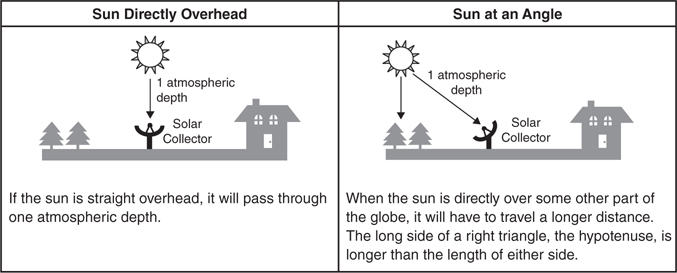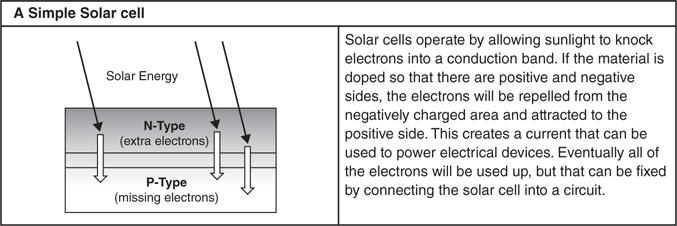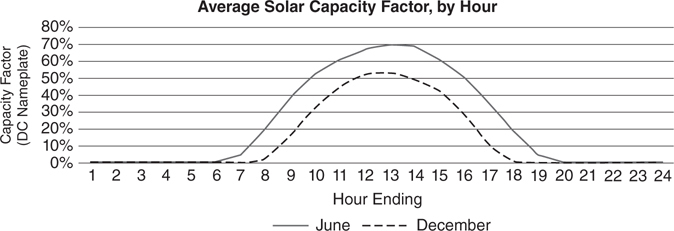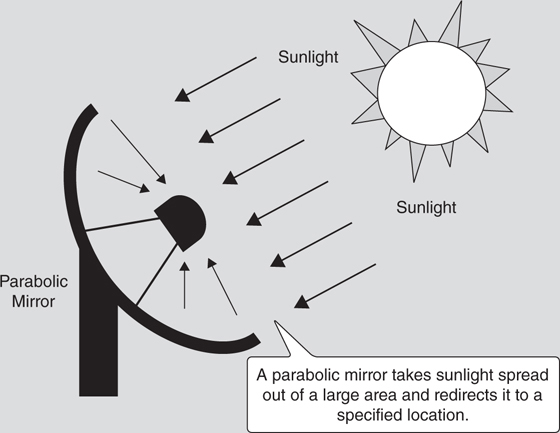4.5
SOLAR POWER
Solar power utilizes energy from the sun to produce electricity or heat. Electricity is most commonly produced by exposing large sheets of specialized semiconductors known as “solar panels” to sunlight. In other cases, mirrors are used to concentrate the heat from a large area onto a single point. This allows the concentrated heat to be used for a variety of purposes like creating steam to drive generators and powering air conditioners.
Solar panels produce electricity directly. Sunlight causes electrons to flow out of the semiconductor panels and into wires connected to a circuit. This creates DC power that can be converted into AC power if necessary. When electricity is generated in this way, it is called photovoltaic (PV) power.
Solar power can also be used to generate heat. This heat can be used to heat homes, warm swimming pools, or generate steam to power an electrical turbine. When solar energy is used to create heat, this is called thermal solar power. Both PV solar power and thermal solar power can be used to generate electricity. However, where PV power uses solar cells, thermal solar power will use stored heat to drive a steam turbine.
For any type of solar power generation, the amount of sunlight available in an area has a big effect on the efficiency of a solar collector. Dry climates at high altitude located close to the equator are generally the best areas to locate solar power units. The reason for this is that sunlight has to pass through the Earth’s atmosphere. The less atmosphere that light has to pass through, the more energy will be available for use in a solar collector (Figure 4.5.1).

Figure 4.5.1 Direction of the sun
The amount of particulate matter suspended in the air also has a large effect on how much sunlight hits the ground. Water vapor, clouds, and dust particles all reduce the output of solar power installations. The combined effects of direct sunlight and particulate matter make certain areas more favorable for solar power than others. For example, in the United States, the Desert Southwest is favorably situated to get a lot of solar power. The region around the Great Lakes receives much less sunlight. Likewise, in Europe, areas around the Mediterranean Ocean get a lot of sunlight, while Northern Europe receives comparatively little.
Concentrated Solar Power
Finally, it’s possible to increase the amount of sunlight that hits a solar panel by collecting it over a large area and focusing it on a specific point. The total effect is a lot like using a magnifying glass on an ant hill during the summer. Sunlight from a wide area is redirected to shine on a very small area. There is trade-off with these systems—sometimes it is better to use a solar collector, in other cases it is easier to use more solar panels. For example, if there is a 10-by-10-foot plot available for a solar collector, it might be better to put in four 5-by-5-foot solar panels and fill the entire space with solar panels. Alternately, it might be better to put in a 10-by-10-foot concentrator and use only a single solar panel.
Particularly with concentrating collectors, but to a lesser extent with all solar installations, it is possible to increase the amount of sunlight hitting a solar collector by facing it toward the sun. In the Northern Hemisphere, this means mounting the unit facing south at a slight upward angle. This can also be improved by placing the solar collector on a motorized base that allows it to track the sun as it moves through the sky. Motorized bases increase the amount of energy that is produced. However, they also increase installation and maintenance costs.
The decision on how to configure a solar installation will depend on the efficiency of the solar panel and the maximum energy that it can absorb. Solar systems are rated by their efficiency at turning sunlight into useful energy. Most solar collectors can only absorb certain wavelengths of light, and much of the light is reflected or absorbed before it can be used. The percentage of the solar energy converted into useful energy is called the conversion efficiency of the solar unit. Conversion efficiency is a measure of energy produced to energy absorbed. Both the availability of solar energy and conversion efficiency of the unit contribute to the output of the unit.
Photovoltaic Power
When solar power is discussed, most commonly it refers to PV power. This type of power is named because of the effect that sunlight has on certain semiconductors. Shining electromagnetic energy like sunlight over a semiconductor will knock some of the electrons away from their nuclei. This effect, called the PV effect, creates an electromagnetic field around the semiconductor. That field can then be converted into electrical current by connecting the two sides of the semiconductor to a circuit. Even though most solar cells are typically reasonably small, they can be connected together into large arrays typically called solar panels.
The basic component of a solar cell is a semiconductor that absorbs some type of electromagnetic energy to produce electricity. One important property of this semiconductor is called its band gap. A band gap is the amount of energy required to kick an electron out of its orbit around a semiconductor nuclei. The normal electron orbit is called the valence band, and an orbit where an electron is free to move around is called the conduction band. When solar energy hits a semiconductor, photons at a lower energy level than the band gap pass through unabsorbed. Photons at an energy level higher than the band gap kick an electron from the valence band into the conduction band. If the energy level of the photon is much higher than the band gap, it will still kick an electron into the conduction gap, but all of the excess energy will be turned into heat.
Once electrons are in the conduction band, they are free to move around. Electrons will move away from negative charges and toward positive charges. To get electrons to move in one direction, it is possible to dope the semiconductor so that one side of it has a positive charge and the other side has a negative charge. A p-type semiconductor is doped with atoms that are missing electrons to give it a positive charge. An n-type semiconductor is doped with atoms that contain excess electrons. A wafer made by sandwiching an n-type and p-type semiconductor will move electrons in a consistent direction. As solar energy hits the n-type semiconductor, an electron is kicked into the conduction band. Once in the conduction band, the electron will move away from the negatively charged side of the semiconductor and move toward the positively charged side. This effect creates an electrical current between the n-type and p-type sides (Figure 4.5.3).

Figure 4.5.3 A simple solar cell
The efficiency of a simple solar cell isn’t particularly high because a lot of solar energy is wasted. One way to reduce the amount of wasted energy is to have several layers of semiconductors. The first layer might be a material with a very high band gap, the next one with a lower band gap, and then the final material the lowest band gap. In this way, less energy is lost to heat, and more energy will be turned into electricity.
Thermal Solar Power
The other way to produce solar energy is to create heat. When sunlight hits almost anything, some of that energy will be absorbed by the object and turned into heat. By concentrating that heat, it is possible to achieve very high temperatures. The heat from thermal solar power is usually used to heat up water or another liquid that is stored in an insulated container until it is ready to be used.
For example, a high-temperature solar facility might use solar power to raise salt to a temperature of approximately 500°F. At that point, salt melts and turns into a liquid. As a liquid, the salt can be transferred into a heavily insulated container until it is ready to be used. This provides a big advantage over PV power—although heat can only be produced at certain times of the day, it doesn’t have to be used right away. A thermal solar plant can use sunlight during the day to build up a store of superheated liquids, and then use that heat to produce electricity at night.
Of course, it might not be worthwhile to produce electricity with that heat. Heat can be used to drive a variety of other activities that may be more valuable than producing electricity. Air conditioning, heating, cooking, sterilization, and dehydration systems can all be built using a heat source. The primary way of producing electricity from heat is through a steam turbine. Steam turbines aren’t particularly efficient when they operate at 500°F. They get much more efficient when they operate at higher temperatures. For examples, a steam turbine operating at 500°F might only turn 40 percent of its heat energy into electricity. A steam turbine operating at 1000°F might be 60 percent efficient. As a result, concentrated heat is more valuable—it is better to have a liquid at 1000°F than it is to have twice as much liquid at 500°F.
To get high temperatures, the key components of a thermal solar system are the solar power concentrator and the heat storage unit. These components directly impact the cost and complexity of thermal solar systems. The primary way to achieve high temperatures is to focus the energy from a large area onto a small point. Since the sun moves through the day, unless a thermal solar system can re-adjust its focus, the location where solar energy is being concentrated will also change. As a result, thermal solar systems commonly rely upon some type of tracking system to keep the energy headed to the right spot.
Solar Production Volume
The amount of solar power produced by a solar farm depends on both the type of solar installation and the location of the installation. Dry, arid climates (like a desert) close to the equator will produce the most power. As the distance from the equator increases, sunlight has to pass through additional layers of atmosphere. This reduces the amount of energy contained in sunlight and decreases solar production. For example, a solar farm located in the Desert Southwest of the United States, like Arizona, would produce more power than a solar farm located in the northeastern United States like New Jersey.
The output of generation units is often described using a capacity factor. The capacity factor is the amount of generation placed onto the power grid relative to the stated size of the unit. For example, a 100-KW solar installation will have a 70 percent capacity factor if it puts 70 KW of AC power onto the power grid. For example, a 70 percent capacity factor would be typical of a solar unit whose size is described relative to its DC size at the middle of the day (Figure 4.5.4).

Figure 4.5.4 Average solar capacity factor, by hour
Over the course of a year, a solar generation facility might have an average annual capacity factor between 10 and 20 percent when the unit is described in DC nameplate terms. This will vary by location and technology. However, given system losses and the fact that it is night approximately half the time, anything above a 35 percent capacity factor would be very unusual (Figure 4.5.5).

Figure 4.5.5 Average solar capacity factor, by month
Technology often has a big impact on generation as well. For example, a fixed-panel solar array will typically have a 13 to 20 percent capacity factor. A solar panel with a fixed tilt that tracks the sun east and west (one-axis tracking) will be 25 to 30 percent more efficient than a fixed panel and typically have a 17 to 25 percent capacity factor. A solar panel that tracks the sun on both the east-west axis and tilts up and down will be 30 to 40 percent more efficient than a fixed panel solar array and have an 18 to 27.5 percent capacity factor.
There is a trade-off between the cost of a solar installation and additional production. Fixed panels have very few moving parts and limited maintenance. By adding motorized components, it is possible for panels to track the sun as it moves through the sky. This will increase the effectiveness of the solar panel. However, motorized units will be more expensive to install and maintain relative to fixed installations.
Trading Example—German Solar Power
Although it doesn’t receive a lot of sunlight, Germany is a world leader in installed PV solar power units. This is a simplified example of how a government subsidy can spur installation of solar power.
1. The Opportunity. As a general rule, solar power is more expensive than fossil-fuel-based power. To encourage consumers to use solar power, the German government adopted a policy of feed-in tariffs that paid homeowners higher than retail prices for any electricity that they fed into the power grid from residentially installed solar systems. This law was made in conjunction with net-metering policies that allowed households to both draw electricity from the power grid and place it back on. At the end of the month, the above-market cost paid for solar power was split evenly between all customers and added as a surcharge to utility bills.
2. The Intuition. This is as easy as a trade gets. Consumers who install solar power on their houses get a rebate on their electricity. Everyone else pays a higher cost. In this case, the rebate is significant—the power grid paid approximately triple the retail price of power. If power costs $30 per MW/H, and you can get paid $90 per MW/H placed onto the grid, almost any solar installation is economical.
3. The Strategy. When homeowners are getting paid triple for any excess capacity that they put on the grid, it pays them to install as much excess capacity as possible. Until you produce more energy than you use, solar power is only worth the avoided cost of buying electricity from the grid. However, after that point, the value of the electricity triples. The best strategy is to load up each house with as much solar capacity as can fit and conserve as much power as possible. That maximizes the net amount of power that can head back onto the power grid.
4. The Risks. There is an economy of scale involved in this trade—the real payoff is placing energy onto the power grid rather than just mitigating home use. Once a homeowner is a net exporter of electricity during daylight hours, it won’t take long for the investment to pay off.
5. The Results. Germany, even with its limited sunlight, has the largest installed base of solar power generation in the world. Utility costs went up slightly for anyone who didn’t install solar power. However, the increase in power prices was fairly minor, and a large portion of Germany’s peak power requirements can be met from solar power.


